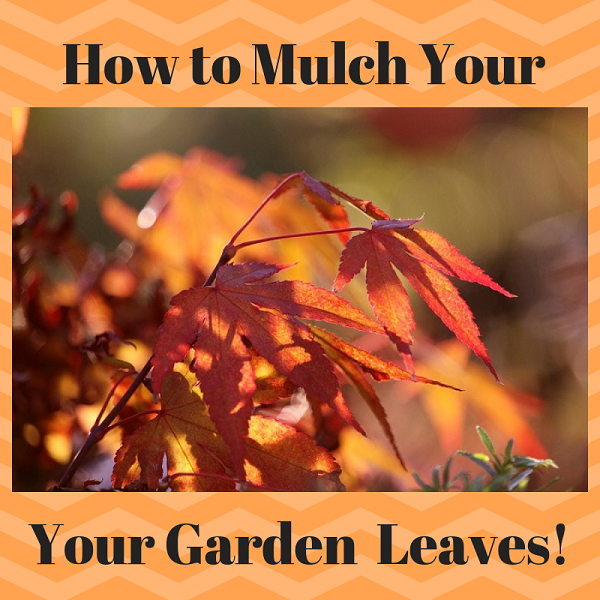How to Mulch from Garden Leaves
 The end of summer season calls for the abundant harvest of potatoes, tomatoes, fruits, and nature’s best collection of leaves. If you are an avid gardener, you must appreciate the value of organic matter. After the earth has frosted up, it’s time to apply your green fertilizer and wait for it to replenish the soil for another season.
The end of summer season calls for the abundant harvest of potatoes, tomatoes, fruits, and nature’s best collection of leaves. If you are an avid gardener, you must appreciate the value of organic matter. After the earth has frosted up, it’s time to apply your green fertilizer and wait for it to replenish the soil for another season.
So, are you wondering how you can get mulch from garden leaves? Well, it is a natural way of getting nutrients to the soil without spending extra on fertilizers. We know how tiring it can get raking all those leaves if you have a series of trees. That’s why with mulching you don’t have to spend hours maintaining your garden. The best areas to mulch leaves are around your trees and vegetable garden since they can absorb the nutrients directly.
Green mulch is also essential in retaining the soil’s moisture. It prevents it from compacting in the cold months of fall and winter.
So how do you go about creating mulch from green leaves?
Here are simple steps to get you rolling with green matter:
-
Identify the reason for Mulching
Is it for weed control or enriching the soil? Either way, you’ll want to know how and when to apply the mulch. For weed control, you’ll want it fresh so that it creates a layer on the ground that prevents light entry; hence killing the weed.
For feeding the soil, it can be ready after shredding or wait for it to acquire a decomposing edge before applying it.
-
Collect the leaves
You can do this by fast blowing them into a pile or by using a sweeper. If you don’t have a wide area to cover, you can always use a blower for the task. The best thing about leaf blowers is that they require small effort to use. An example of an ideal leaf blower for this task can be seen here https://wonderlandgardens.org/best-cordless-leaf-blower/
-
Shred up the Leaves
After you have collected as much as you can from the ground, it’s time to use a leaf shredder. A good mulcher uses a hopper and blades or a trimmer to reduce the leaf volume to a small quantity. The essence here is to have the leaves break down fast over the winter season. Whole leaves are quite hard to disintegrate.
If you are dealing with small-sized leaves like seen on compound plants, you can always add them directly to a heap as discussed in our next step.
-
Add the Shredded Leaves to a Bin or Plastic bag
Here, you’ll want to layer the leaves in the bin while adding some nutrients to go along with them. Add ammonium nitrate or urea as a method of adding nitrogen to the leaves to hasten the breakdown process. After this, sprinkle some water on the leaves ensuring that you do not soak them. You can create a few layers of the mix in your bin or in several bags to have abundant mulch.
Ensure to seal the bin with a plastic paper or if you are using garbage bags seal them nicely. If you are pouring the leaves onto the ground in one pile, border it up with pieces of wood such that they do not get blown away by the wind even after you cover it up.
-
Use the Mulch
You don’t wait for mulch to decompose or else it becomes compost. In spring, your mulch is ready for application directly to the soil. You’ll start seeing the benefits of your mulch one year down the line as it fully decomposes. You can use it on garlic, roses, and delicate perennials.
-
A Straightforward Method to Mulch from Green Leaves
You may not have the time to go through the steps of mulching. But still, you can mulch right away. Remember that the leaves do not need to decompose. In fact, the lighter it is, the better it functions. For those that want mulch for your grass lawn, simply use a mower to shred the leaves as you mow. When the mower discharges the clippings, you’ll have a clean surface of green mulch. You can use a spreader if you feel the mower has not done a good job when discharging.
-
Finally
If you’re doing this for lawn care, it’s important to know that mulch cannot revive a dying lawn. Dig up a new one before applying the mulch so that as the months roll by, it will release the nutrients into the soil.
Thank you to Oliver @ Wonderlandgardens.org/ for providing this information!
How do you protect your plants and nourish them? Do you use green mulch? Do you have any suggestions or tips?
Please leave or ideas and thoughts in the comment section!



Pingback: Homestead Blog Hop 154 – Live The Old Way
Pingback: Organic Gardening Facts: Why You Should Grow Your Own Food - bean post farmstead
Pingback: 3 Simple Ways to Make Your Own Mulch
Pingback: Homestead Blog Hop #154 - The Not So Modern Housewife